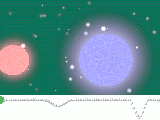Hello everyone, I'm working on a concept for adventure story, but firstly, let me show you.

That's the planet in the question. Yes, it's inspired by Kepler-16b, the real life "Tatooine". Ruu orbits two host stars Paika and Miami (pronounce miæmaɪˈ, reverse of Florida's Miami) but I'm not curtain how's that gonna effect Ruu's weather.
I think that when Ruu orbit closer to Paika, it'd get more energy than when it's closer to Miami; then, Ruu will have several summers a year, am I right? And as Paika and Miami eclipse each other, there will be dim times in a sky of Ruu, am I correct? Then another question, during the eclipse period the temperature would be colder on Ruu right?

That's the planet in the question. Yes, it's inspired by Kepler-16b, the real life "Tatooine". Ruu orbits two host stars Paika and Miami (pronounce miæmaɪˈ, reverse of Florida's Miami) but I'm not curtain how's that gonna effect Ruu's weather.
I think that when Ruu orbit closer to Paika, it'd get more energy than when it's closer to Miami; then, Ruu will have several summers a year, am I right? And as Paika and Miami eclipse each other, there will be dim times in a sky of Ruu, am I correct? Then another question, during the eclipse period the temperature would be colder on Ruu right?


